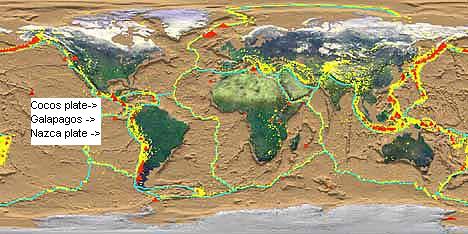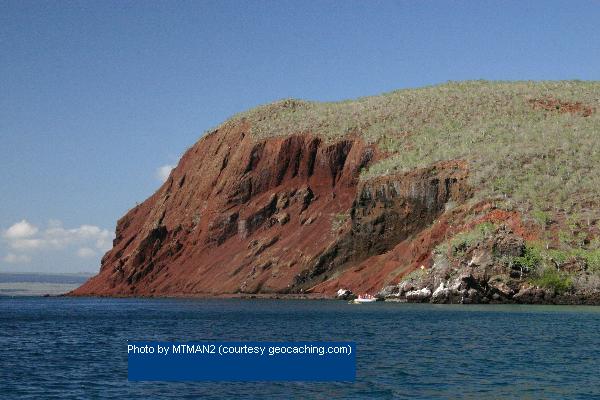The Galapagos Islands were upthrust by volcano building directly resulting from tectonic activity at the divergent plate boundary of the Nazca and Cocos plates. A major transform fault is located just north of the Galapagos at 91° West, and a major subduction zone is located along the west coast of Central and South America, where the Nazca and Cocos Plates are subducting beneath the South American and Caribbean plates. These forces have combined and affected each other to build the Galapgos we know today.

Picture courtesy NASA, notations added by Peter Baker. The seabeds are light brown, the continents are in relief. The green lines are plate boundaries. Red dots indicate volcanic activity and the yellow dots are earthquakes. Note how earthquakes and volcanism are concentrated along plate boundaries.
The Galapagos Archipelago, with its many volcanoes and location near the divergent boundary of the Nazca and Cocos plates, appears at first glance to be a ridge-centered hotspot. However, Sinton (1992) states that "...the Galapagos archipelago provides an important example of a hotspot setting that is midway between a ridge-centered hotspot, such as Iceland, and and intraplate hotspot, like Hawaii."
Sinton (1992) found that the volcanism of the Galapagos is more complex than just a ridge-centered hotspot. The main platform has been migrating in the direction of the Nazca plate, but the volcanism found to the north of the main platform could not have formed at a hotspot location on the platform's western edge.
The material erupting from the volcaoes began as a vertical plume of asthenospheric matter as would be expected over a divergent boundary. Over time, however, the plate has moved and sheared off a large deposit. Heat and pressure have combined to keep it viscous enough to continue erupting. In addition, there is evidence that solid matter is re-melting under these same terrific forces. Most, but not all, of the currently active Galapagos volcanoes share identical lava.
Erosion on the Galapagos is primarily due to ocean waves. Lacking glaciers or significant rain, the loose volcanic soils are able to remain largely in place. At the shores the wave energy has relentlessly eroded several of the islands, as can be seen in this photograph of Rabida.

photo by MTMAN2 courtesy geocaching.com
Last modified: 5/25/2007 3:03 PM